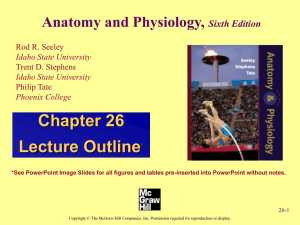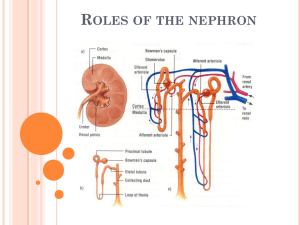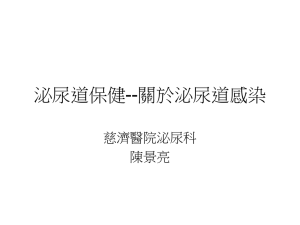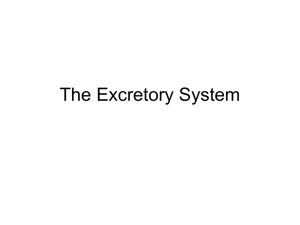Urinary System
advertisement
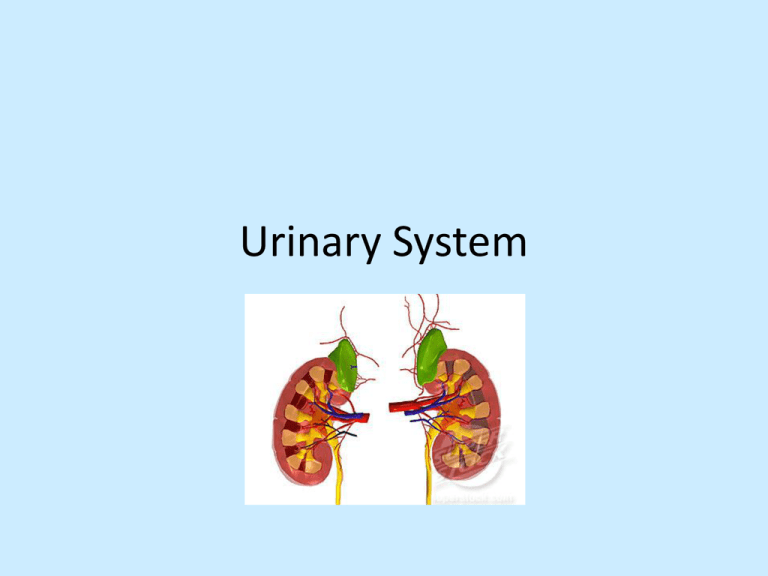
Urinary System Functions • Maintains homeostasis in blood by: 1. Regulating : – blood pressure by blood volume +, K+, & 2+ – ion , e.g. – blood by maintaining concentration of H+ & HCO3- 2. Remove nitrogenous waste from metabolism, e.g. urea, , & creatinine – recall: most ammonia (NH3) from amino acid converted into less toxic urea by liver 3. Remove other excess vitamins compounds, e.g. hormones & – must conserve nutrients, e.g. water, glucose, & amino acids • cv renal artery • both branch off aorta • each artery blood to one kidney to be filtered • also supplies blood to one kidney renal vein • both join with posterior vena cava • each vein filtered blood from one kidney, which contains substances reabsorbed during formation ureters: • tubes that carry urine from renal pelvis to urinary bladder urethra: • tube that carries urine from urinary bladder to of body urinary bladder: • muscular sac that stores urine prior to urination • when sac stretches to certain point, sends messages to to notify need to urinate Kidney • organ that filters blood to remove wastes and regulates of blood plasma • contains nephrons: functional unit of that forms urine Parts of the Kidney Cortex • layer of kidneys (renal = kidneys, = outer layer) Renal medulla • inner of kidneys • has higher concentration than cortex + and because contains urea Renal pelvis • inner chamber of kidneys, where urine from collecting ducts before entering Urine Formation Nephron • Approximately one million per a kidney • Blood supply enters the in the renal artery and branches into capillaries • Blood is filtered as it passes the capillaries where wastes (filtrate) is out as urine and nutrients are kept in the to be used throughout the body Bowman’s Capsule • Located at the “end” of the nephron • In the of the kidney • Surrounds the (a knot of capillaries) Peritubular capillaries Glomerulus - Pressure Filtration • • • • • blood from renal artery enters through afferent and exits through efferent efferent arteriole has smaller diameter than afferent arteriole, which pressure in glomerulus blood forces fluids & small dissolved in blood through pores in capillary walls from glomerulus into in Bowman’s capsule substances that: 1. remain in capillaries: , , platelets, blood proteins (e.g. globulins), , & certain drugs (e.g. penicillin) 2. enters filtrate: water, glucose, amino acids, ions (e.g. Na+, Cl–, H+, K+, & HCO3–), vitamins, & nitrogen waste (e.g. uric acid, urea, & NH3) filtrate from Bowman’s capsules enters tubular system, where substances exchange with blood in capillaries Proximal Convoluted Tubule - Tubular (Selective) Reabsorption • • In the of the kidney nutrients actively transported back into blood in capillaries, e.g. glucose & amino acids – NOTE: all glucose from filtrate, but some glucose used for active transport • • • less glucose in efferent arteriole than afferent arteriole Most ions (Na+) actively transported back into blood, which causes transport – of negative ions (Cl ) by diffusion and water by back into blood substances remaining in filtrate: –, & water, Na+, nitrogenous waste peritubular capillary proximal convoluted tubule Loop of Henle: Tubular Reabsorption • as filtrate down descending limb, increasing solute concentration of renal causes water to diffuse out of filtrate by osmosis, i.e. becomes more concentrated as water content of filtrate decreases as it passes through – descending limb permeable to water, but impermeable to ions • as filtrate moves up ascending limb, Na+ actively out of filtrate, i.e. becomes less concentrated – ascending limb impermeable to water, which prevents water from diffusing back into filtrate by In renal medulla Distal Convoluted Tubule - Tubular Secretion • Takes place in the renal cortex • More Na+ actively reabsorbed from back into blood in peritubular capillaries, which causes more Cl– and water to move out • Hormones, , creatinine, & excess K+ in blood actively transported from into filtrate for excretion • Blood increased by secreting excess H+ into filtrate & HCO3– from filtrate Collecting Duct - Tubular Excretion • Takes place in the renal medulla • As moves through higher concentration gradient in renal medulla, water out by osmosis • Some urea also diffuses out of the duct to contribute to the high solute concentration of the inner medulla • Urine nephron merges in renal pelvis pH • Essentially, the kidneys are bicarbonate ions and excreting hydrogen ions as the blood a normal pH – If the blood is acidic, H+ ions are excreted and HCO3- ion are reabsorbed into blood – If the blood is basic, H+ ions are not excreted and HCO3- ions are not reabsorbed and are passed into the filterate Pathway of Urine • As the urine passes through the ducts, it is drained into the pelvis of the kidney, then the ureters and to the – Stretch receptors signal internal sphincters to relax for urination – Sphincters close the urethra until the urge becomes necessity (at approximately 600mL) – voluntary (external) sphincters can be controlled to prevent urination until convenient Pathway: 1. blood: artery afferent arteriole glomerulus efferent peritubular capillary network renal vein 2. urine: renal pelvis in kidney ureter urinary bladder Regulation Salt Regulation by Kidneys Blood volume, pressure, & salt concentration regulated by stimulating or inhibiting secretion of to control water content of blood Aldosterone • Is a that increases the blood volume by increasing reabsorption of Na+ ions at the distal tubule, which increases reabsorption of water by osmosis – i.e. in blood water by increasing Na+ • Produced and secreted by adrenal cortex (outer layer of glands, which sits above kidney) • Secretion controlled by juxtaglomerular apparatus between afferent arteriole & distal convoluted tubule in nephron, which blood volume • When juxtaglomerular apparatus detects blood flow caused by low blood volume, then stimulates of enzyme renin from kidneys that catalyzes production of angiotensin II from angiotensinogen • II stimulates secretion of aldosterone from the adrenal cortex – NOTE: angiotensin II also causes blood vessels to constrict raising blood pressure Antidiuretic Hormone (ADH) • Is a hormone that increases water content of blood by increasing permeability of distal tubule and the collecting duct to increase reabsorption of water by – i.e. conserves water by increasing urine concentration and volume of urine produced – produced by & stored/secreted by posterior pituitary gland – secretion controlled by hypothalamus & on solute concentration in blood, i.e. more water reabsorbed into blood plasma when water in blood decreases – when in hypothalamus detect increased solute concentration in blood, stimulates secretion of ADH from posterior gland – reabsorbing more water causes increased blood , which increases blood pressure & salt concentration Water Regulation by Kidneys • The water content of the body can vary depending on various factors: – – – – – • • • • water intake diarrhea vomiting sweating drinking alcohol (inhibits ADH production) This means that the body has too little water and needs to conserve it and sometimes too much water and needs to get rid of it. Most of the of water conservation takes place in the distal and collecting tubules of the nephrons under the control of anti-diuretic hormone (ADH) If the contains too little water (indicating dehydration) then more ADH is released so that the kidneys can reabsorb more water, thereby decreasing urine volume and increasing urine concentration (urine color = dark yellow). If the blood too much water (indicating over-hydration) then less ADH is released into the blood stream so that the kidneys don`t reasborb as much water, increasing urine volume and urine concentration (urine colour = less yellow) By the end of this section, you should be able to: • dentify and explain the functions of each of the following: – kidney – ureter – urethra – urinary bladder – renal cortex – renal medulla – renal pelvis – nephron • identify and explain the functions of the following components of the nephron: – glomerulus – Bowman’s capsule – afferent and efferent arterioles – peritubular capillary network – proximal and distal convoluted tubules – collecting duct – loop of Henle • describe the production of urine with reference to the following terms: – pressure filtration – selective reabsorption – reabsorption of water following an osmotic gradient – tubular excretion – metabolic waste (e.g., nitrogenous waste, urea, ammonia) • describe how the kidneys maintain blood pH • compare urea and glucose content of blood in the renal artery with that of the renal vein • identify the source glands for antidiuretic hormone (ADH) and aldosterone • describe how the hypothalamus, posterior pituitary, ADH, and the nephron achieve homeostasis of water levels in the blood • describe how the adrenal cortex, aldosterone, and the nephron achieve homeostasis of water and sodium levels in the blood Mandatory Vocabulary antidiuretic hormone (ADH), adrenal cortex, afferent and efferent arterioles, aldosterone, ammonia, Bowman’s capsule, collecting duct, glomerulus, glucose, homeostasis, hypothalamus, kidney, loop of Henle, metabolic waste, nephron, nitrogenous waste, osmotic gradient, peritubular capillary network, pH, posterior pituitary, pressure filtration, proximal and distal convoluted tubules, reabsorption of water, renal artery, renal cortex, renal medulla, renal pelvis, renal vein, selective reabsorption, tubular excretion, urea, ureter, urethra, urinary bladder, urine
